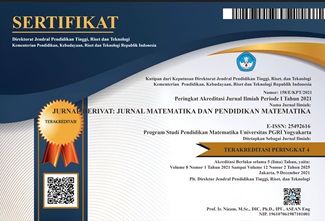Pengembangan E-modul Berbantuan Software Algebrator pada Materi Bilangan Berpangkat dan Bentuk Akar Kelas X SMK
DOI:
https://doi.org/10.31316/j.derivat.v8i2.1862Abstract
The use of technology in education has a significant impact in educating and educating the nation's life, and can help create new innovations. One of the innovations created is the emergence of the concept of electronic learning (e-learning). E-learning is useful for students and teachers to get learning materials easily, one of which is by using e-module teaching materials. This study aims to determine the process and produce a product in the form of an e-module of teaching materials assisted by algebrator software on the material of rank numbers and root forms for class X SMK. This type of research is development using ADDIE floating model. The instrument used in this study is a non-test instrument, namely a validation questionnaire, and the data obtained from a validation questionnaire that has been filled out by the validator. The data will be analyzed descriptively quantitatively. Overall, the feasibility of the e-module assisted by algebrator software on the material of numbers and root forms obtained an average of 86.35%, so that the e-module assisted by algebrator software on the material of numbers and roots of class X SMK is interpreted as very valid to use.
Â
Kata Kunci: E-module, Algebrator Software, Exponents and Roots, Validity
References
Akbar, S. (2017). Instrumen Perangkat Pembelajaran. In Bandung: PT. Reamaja Rosdakarya.
Aholongan, A., Suripah, S., Amelia, S., & Yolanda, F. (2021). Minat Peserta Didik Terhadap Penggunaan Software Algebrator Sebagai Media dalam Proses Pembelajaran Daring pada Materi Bilangan. Jurnal Cendekia : Jurnal Pendidikan Matematika, 5(2), 1834–1841. https://doi.org/10.31004/cendekia.v5i2.736
Dahar, R. W. (2011). Teori-teori Belajar dan Pembelajaran. In Jakarta: Erlangga.
Husniah, M. (2018). Pengembangan E-Modul Berbasis Model Pembelajaran Problem Based Learning Mata Pelajaran Pai Materi Akhlak Siswa Kelas X Sma Negeri 1 Turen. Universitas Islam Negeri Maulana Malik Ibrahim, 1126.
Imansari, N., & Sunaryantiningsih, I. (2017). Pengaruh Penggunaan E-Modul Interaktif Terhadap Hasil Belajar Mahasiswa pada Materi Kesehatan dan Keselamatan Kerja. VOLT : Jurnal Ilmiah Pendidikan Teknik Elektro, 2(1), 11. https://doi.org/10.30870/volt.v2i1.1478
Magdalena, I., Sundari, T., Nurkamilah, S., Nasrullah, & Amalia, D. A. (2020). Analisis Bahan Ajar. Nusantara : Jurnal Pendidikan Dan Ilmu Sosial, 2(2), 311–326.
Mulyatiningsih, E. (2011). Riset Terapan Bidang Pendidikan dan Teknik. In Yogyakarta: UNY Press.
Nuriansyah, F. (2020). Efektifitas Penggunaan Media Online Dalam Meningkatkan Hasil Belajar Pada Mahasiswa Pendidikan Ekonomi Saat Awal Pandemi Covid-19. Jurnal Pendididikan Ekonomi Indonesia, 1(2), 6165.
Pratomo, H. (2020). From social distancing to physical distancing: A challenge forevaluating public health intervention against covid-19. Kesmas: Jurnal Kesehatan Masyarakat Nasional, 15(2), 6063. https://doi.org/10.21109/KESMAS.V15I2.4010
Sari, N., Rezeki, S., & Ariawan, R. (2019). Materi Himpunan Terintegrasi Keislaman: Sebuah Studi Pengembangan Perangkat Pembelajaran berbasis Model Problem Based Learning. Al-Khwarizmi: Jurnal Pendidikan Matematika Dan Ilmu Pengetahuan Alam, 7(1), 5360. https://doi.org/10.24256/jpmipa.v7i1.562
Sholikhah, A. (2016). Statistik Deskriptif dalam Penelitian Kualitatif. Komunika, 10(2), 342.
Sugiyono. (2019). Metode Penelitian Kuantitatif, Kualitatif, dan R&D. In Bandung: Alfabeta.
Sulistyarini, D. A. (2016). Analisis Kesulitan Siswa SMKK Citra Medika Sukoharjo dalam Menyelesaikan Soal Bentuk Akar dan Alternatif Pemecahannya. Prosiding Konferensi Nasional Penelitian Matematika Dan Pembelajarannya (KNPMP), 1(KNPMP 1), 605614.
Suripah, & Retnawati, H. (2019a). Student Mathematical Connection Ability in Representing Multiplication at the Elementary School. Journal of Physics: Conference Series, 1254(1). https://doi.org/10.1088/1742-6596/1254/1/012080
Suripah, S., & Retnawati, H. (2019b). Investigating students mathematical creative thinking skill based on academic level and gender. International Journal of Scientific and Technology Research, 8(8), 227231.
Susanti, W. D., & Suripah, S. (2021). The Effectiveness of Website as a Mathematics Learning Media During the Online Learning Period. Edumatica : Jurnal Pendidikan Matematika, 11(01), 73–83. https://doi.org/https://doi.org/10.22437/edumatica.v11i01.12225
Umbara, U., & Rahmawati, I. (2018). Pembelajaran Matematika Berbantuan Software Algebrator untuk Meningkatkan Kemampuan Pemahaman Matematis Siswa. Jurnal Elemen, 4(1), 9. https://doi.org/10.29408/jel.v4i1.508
Wena, M. (2013). Strategi Pembelajaran Inovatif Kontemporer: Suatu Tinjauan Konseptual Operasional. In Jakarta: Bumi Aksara.
Downloads
Published
Issue
Section
Citation Check
License
Authors who publish with this journal agree to the following terms:
-
Authors retain copyright and grant the journal right of first publication with the work simultaneously licensed under a Creative Commons Attribution-ShareAlike 4.0 International License that allows others to share the work with an acknowledgment of the work's authorship and initial publication in this journal.
- Authors are able to enter into separate, additional contractual arrangements for the non-exclusive distribution of the journal's published version of the work (e.g., post it to an institutional repository or publish it in a book), with an acknowledgment of its initial publication in this journal.
- Authors are permitted and encouraged to post their work online (e.g., in institutional repositories or on their website) prior to and during the submission process, as it can lead to productive exchanges, as well as earlier and greater citation of published work (See The Effect of Open Access).







